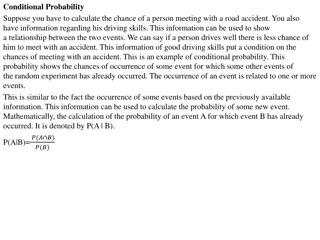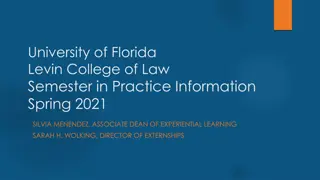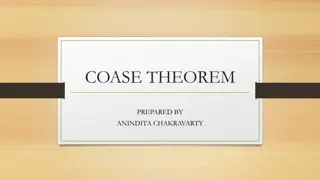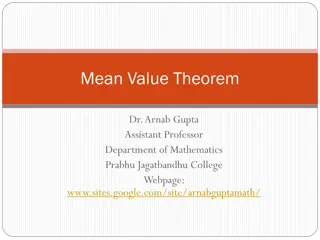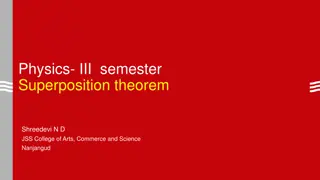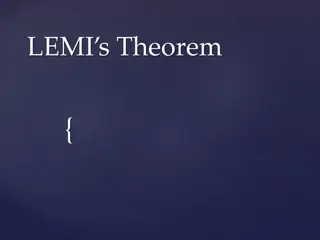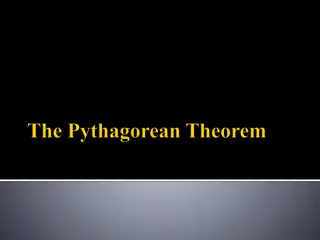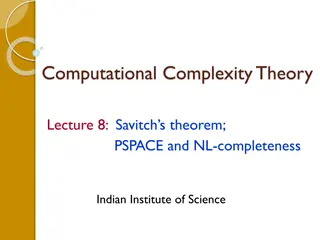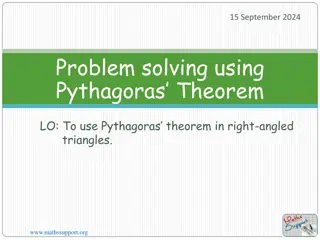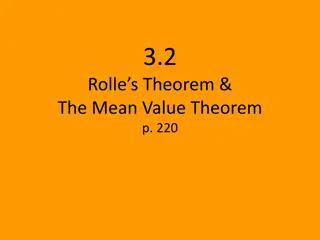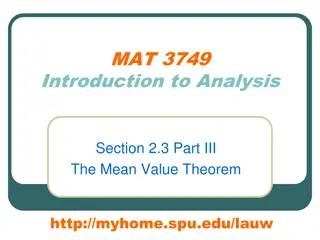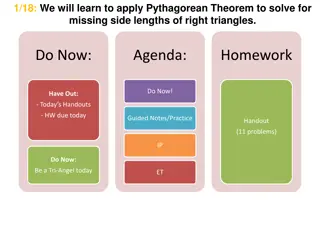Complexity Theory Lecture 3: Cook-Levin Theorem Overview
Dive into Complexity Theory with Lecture 3 covering the Cook-Levin Theorem, NP complexity classes, NP-completeness, and a natural NP-complete problem. Explore proofs and key concepts in computational complexity.
Download Presentation

Please find below an Image/Link to download the presentation.
The content on the website is provided AS IS for your information and personal use only. It may not be sold, licensed, or shared on other websites without obtaining consent from the author.If you encounter any issues during the download, it is possible that the publisher has removed the file from their server.
You are allowed to download the files provided on this website for personal or commercial use, subject to the condition that they are used lawfully. All files are the property of their respective owners.
The content on the website is provided AS IS for your information and personal use only. It may not be sold, licensed, or shared on other websites without obtaining consent from the author.
E N D
Presentation Transcript
Computational Complexity Theory Lecture 3: Cook-Levin Theorem Indian Institute of Science
Recap: Complexity Class NP Definition. A language L {0,1}* is in NP if there s a polynomial function p: N TM M (called the verifier) such that for every x, N and a polynomial time x L u {0,1}p(|x|) s.t. M(x, u) = 1 u is called a certificate or witness for x (w.r.t L and M) if x L
Recap: Polynomial time reduction Definition. We say a language L1 {0,1}* is polynomial time (Karp) reducible to a language L2 {0,1}* if there s a polynomial time computable function f s.t. x L1 f(x) L2 f(L1) L1 L2 L2 L1 f(L1)
Recap: NP-completeness Definition. A language L is NP-hard if for every L in NP, L pL . Further, L is NP-complete if L is in NP and is NP-hard. Observe. If L is NP-hard and L is in P then P = NP. If L is NP-complete then L in P if and only if P = NP. Hardest problems inside NP in the sense that if one NPC problem is in P then all problems in NP is in P. NPC NP P
Recap: A natural NP-complete problem Definition. A boolean formula is in Conjunctive Normal Form (CNF) if it is an AND of OR of literals. e.g. = (x1 x2) (x3 x2 ) Definition. Let SAT be the language consisting of all satisfiable CNF formulae. Theorem. (Cook-Levin) SAT is NP-complete. Easy to see that SAT is in NP. Need to show that SAT is NP-hard.
Cook-Levin theorem: Proof Main idea: Computation is local; i.e. every step of computation looks at and changes only constantly many bits; and this step can be implemented by a small CNF formula. Let L NP. We intend to come up with a polynomial time computable function f: x x s.t., x L x SAT Notation: | x| := size of x = number of or in x
Cook-Levin theorem: Proof Language L has a poly-time verifier M such that x L u {0,1}p(|x|) s.t. M(x, u) = 1 Idea: Capture the computation of M(x, ..) by a CNF x such that u {0,1}p(|x|) s.t. M(x, u) = 1 x is satisfiable For any fixed x, M(x, ..) is a deterministic TM that takes u as input and runs in time polynomial in |u|.
Cook-Levin theorem: Proof Main Theorem. Let N be a deterministic TM that runs in time T(n) on every input u of length n, and outputs 0/1. Then, 1. There s a CNF of size poly(T(n)) such that (u, auxiliary variables ) is satisfiable as a function of the auxiliary variables if and only if N(u) =1. 2. is computable in time poly(T(n)).
Cook-Levin theorem: Proof Main Theorem. Let N be a deterministic TM that runs in time T(n) on every input u of length n, and outputs 0/1. Then, 1. There s a CNF of size poly(T(n)) such that (u, auxiliary variables ) is satisfiable as a function of the auxiliary variables if and only if N(u) =1. 2. is computable in time poly(T(n)). (u, auxiliary variables ) is satisfiable as a function of all variablesif and only if u s.t N(u) =1.
Cook-Levin theorem: Proof Main Theorem. Let N be a deterministic TM that runs in time T(n) on every input u of length n, and outputs 0/1. Then, 1. There s a CNF of size poly(T(n)) such that (u, auxiliary variables ) is satisfiable as a function of the auxiliary variables if and only if N(u) =1. 2. is computable in time poly(T(n)). Cook-Levin theorem follows from above!
Main theorem: Proof Step 1. Let N be a deterministic TM that runs in time T(n) on every input u of length n, and outputs 0/1. Then, 1. There s a boolean circuit of size poly(T(n)) such that (u) = 1 if and only if N(u) =1. 2. is computable in time poly(T(n)). Step 2. Convert circuit to a CNF efficiently by introducing auxiliary variables.
Main theorem: Step 1 Assume (w.l.o.g) that N has a single tape and it writes its output on the first cell at the end of computation.
Main theorem: Step 1 Assume (w.l.o.g) that N has a single tape and it writes its output on the first cell at the end of computation. A step of computation of N consists of Changing the content of the current cell Changing state Changing head position
Main theorem: Step 1 Assume (w.l.o.g) that N has a single tape and it writes its output on the first cell at the end of computation. A step of computation of N consists of Changing the content of the current cell Changing state Changing head position Think of a compound tape: every cell stores the current state, a bit content and head indicator.
Main theorem: Step 1 . . a cell A compound tape
Main theorem: Step 1 h Q b . . a cell A compound tape
Main theorem: Step 1 h = 1 if head points to this cell = 0 otherwise h Q b . . a cell A compound tape
Main theorem: Step 1 0/1 bit content of this cell h Q b . . a cell A compound tape
Main theorem: Step 1 Current state when h = 1; otherwise we don t care h Q b . . a cell A compound tape
Main theorem: Step 1 Computation of N can be completely described by a sequence of T(n) compound tapes, the i-th of which captures a `snapshot of N s computation at the i-th step. . . a cell A compound tape
Main theorem: Step 1 . . qstart u1 1 a cell 1 A compound tape first input bit
Main theorem: Step 1 . . qstart u1 0 2 . . qstart u1 1 a cell 1 A compound tape
Main theorem: Step 1 T(n) cells T(n) . . qaccept o/p 1 . . . . . qstart u1 0 2 . . qstart u1 1 a cell 1 A compound tape
Main theorem: Step 1 hi,j = 1 iff head points to cell j at i-th step bi,j = bit content of cell j at i-th step qi,j = a sequence of log |Q| bits which contains the current state info if hi,j = 1; otherwise we don t care . . qi,j bi,j hi,j i cell j
Main theorem: Step 1 Locality of computation: The bits in hi,j, bi,j and qi,j depend only on the bits in hi-1,j-1 , bi-1,j-1 ,qi-1,j-1 , hi-1,j , bi-1,j ,qi-1,j , and hi-1,j+1 , bi-1,j+1 ,qi-1,j+1 . . qi,j bi,j hi,j i cell j . . qi-1,j-1 bi-1,j-1 hi-1,j-1 qi-1,j bi-1,j hi-1,j qi-1,j+1 bi-1,j+1 hi-1,j+1 i-1 cell j-1 cell j cell j+1
Main theorem: Step 1 Locality of computation: The bits in hi,j, bi,j and qi,j depend only on the bits in hi-1,j-1 , bi-1,j-1 ,qi-1,j-1 , hi-1,j , bi-1,j ,qi-1,j , and hi-1,j+1 , bi-1,j+1 ,qi-1,j+1 . . qi,j bi,j hi,j i constant size circuit . . qi-1,j-1 bi-1,j-1 hi-1,j-1 qi-1,j bi-1,j hi-1,j qi-1,j+1 bi-1,j+1 hi-1,j+1 i-1 cell j-1 cell j cell j+1
Main theorem: Step 1 Output of T(n) . . qaccept o/p 1 . . . . . qstart u1 0 2 . . qstart u1 1 a cell 1 . Circuit Input u-variables of
Main theorem: Step 1 Output of T(n) . . qaccept o/p 1 . . . . . qstart u1 0 2 . . qstart u1 1 a cell 1 . Observe: (u) = 1 iff N(u) = 1 Input u-variables of
Main theorem: Step 2 Think of hi,j, bi,j and the bits of qi,j as formal boolean variables. auxiliary variables . . qi,j bi,j hi,j i cell j
Main theorem: Step 2 Locality of computation: The variables hi,j, bi,j and qi,j depend only on the variables hi-1,j-1 , bi-1,j-1 ,qi-1,j-1 , hi-1,j , bi-1,j ,qi-1,j , and hi-1,j+1 , bi-1,j+1 ,qi-1,j+1 . . qi,j bi,j hi,j i cell j . . qi-1,j-1 bi-1,j-1 hi-1,j-1 qi-1,j bi-1,j hi-1,j qi-1,j+1 bi-1,j+1 hi-1,j+1 i-1 cell j-1 cell j cell j+1
Main theorem: Step 2 Hence, bij = Bij(hi-1,j-1 , bi-1,j-1 ,qi-1,j-1 , hi-1,j , bi-1,j ,qi-1,j , hi-1,j+1 , bi-1,j+1 ,qi-1,j+1) = a fixed function of the arguments depending only on N s transition function . The above equality can be captured by a constant size CNF ij . Also, ij is easily computable from .
Main theorem: Step 2 Similarly, hij = Hij(hi-1,j-1 , bi-1,j-1 ,qi-1,j-1 , hi-1,j , bi-1,j ,qi-1,j , hi-1,j+1 , bi-1,j+1 ,qi-1,j+1) = a fixed function of the arguments depending only on N s transition function . The above equality can be captured by a constant size CNF ij . Also, ij is easily computable from .
Main theorem: Step 2 k-th bit of qij where 1 k log |Q| Similarly, qijk = Cijk(hi-1,j-1 , bi-1,j-1 ,qi-1,j-1 , hi-1,j , bi-1,j ,qi-1,j , hi-1,j+1 , bi-1,j+1 ,qi-1,j+1) = a fixed function of the arguments depending only on N s transition function . The above equality can be captured by a constant size CNF ijk . Also, ijk is easily computable from .
Main theorem: Step 2 Let be the conjunction of ij , ij and ijk for all i, j, k. i [1, T(n)] , j [1, T(n)] , and k [1, log |Q|] is a CNF in the u-variables and the auxiliary variables. Size of is O(T(n)2).
Main theorem: Step 2 Let be the conjunction of ij , ij and ijk for all i, j, k. i [1, T(n)] , j [1, T(n)] , and k [1, log |Q|] is a CNF in the u-variables and the auxiliary variables. Size of is O(T(n)2). Define = (bT(n),1 = 1) Convert to CNF
Main theorem: Step 2 Observe: An assignment to u and the auxiliary variables satisfies if and only if it captures computation of N on the assigned input u.
Main theorem: Step 2 Observe: An assignment to u and the auxiliary variables satisfies if and only if it captures computation of N on the assigned input u. Hence, an assignment to u and the auxiliary variables satisfies if and only if N outputs 1 on the assigned input u.
Main theorem: Step 2 Observe: An assignment to u and the auxiliary variables satisfies if and only if it captures computation of N on the assigned input u. Hence, an assignment to u and the auxiliary variables satisfies if and only if N outputs 1 on the assigned input u, i.e. (u, auxiliary variables ) is satisfiable iff N(u) =1.
Main theorem: Comments is a CNF of size O(T(n)2) and is also computable from N in O(T(n)2) time. is a function of u (the input) and some auxiliary variables (the bij, hij and qijk variables). (u, auxiliary variables ) is satisfiable iff N(u) =1. Q.E.D
Main theorem: Comments With some more effort, size can be brought down to O(T(n). log T(n)).
Main theorem: Comments With some more effort, size can be brought down to O(T(n). log T(n)). The reduction from N, u to (u, ) is not just a poly- time reduction, it is actually a log-space reduction(we ll define this later).
Main theorem: Comments With some more effort, size can be brought down to O(T(n). log T(n)). The reduction from N, u to (u, ) is not just a poly- time reduction, it is actually a log-space reduction(we ll define this later). Observe that once u is fixed the values of the auxiliary variables are also determined in any satisfying assignment for .
Main theorem: Comments With some more effort, size can be brought down to O(T(n). log T(n)). The reduction from N, u to (u, ) is not just a poly- time reduction, it is actually a log-space reduction(we ll define this later). Each clause of has only constantly many literals!
3SAT is NP-complete Definition. A CNF is a called a kCNF if every clause has at most k literals. e.g. a 2CNF = (x1 x2) (x3 x2 ) Definition. kSAT is the language consisting of all satisfiable kCNFs.
3SAT is NP-complete Definition. A CNF is a called a kCNF if every clause has at most k literals. e.g. a 2CNF = (x1 x2) (x3 x2 ) Definition. kSAT is the language consisting of all satisfiable kCNFs. Cook-Levin. There s some constant k such that kSAT is NP-complete.
3SAT is NP-complete Definition. A CNF is a called a kCNF if every clause has at most k literals. e.g. a 2CNF = (x1 x2) (x3 x2 ) Definition. kSAT is the language consisting of all satisfiable kCNFs. Theorem. 3SAT is NP-complete. Proof sketch: (x1 x2 x3 x4 ) is satisfiable iff (x1 x2 z) ( x3 x4 z) is satisfiable.


